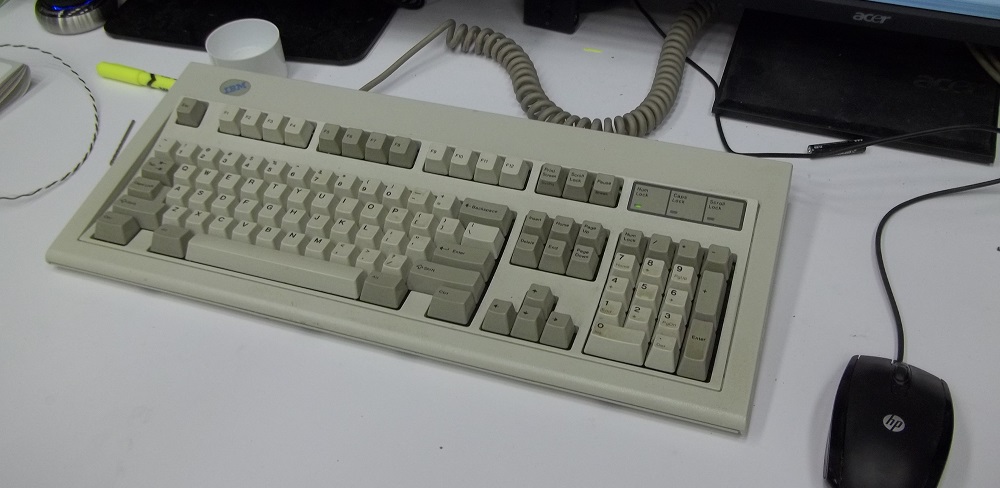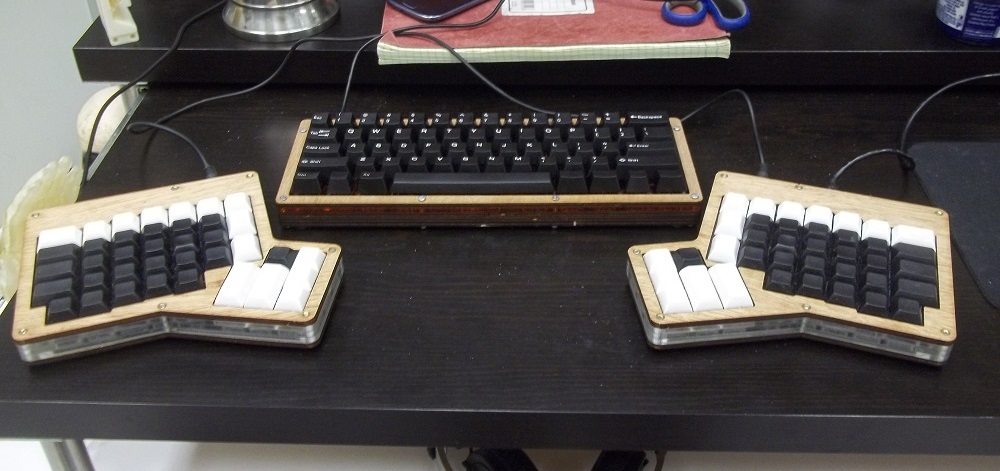Clickety clack clack,
My fingers echo and sing,
Sorry-not-sorry
Despite being in a lab primarily focused in mechanical engineering, I still spend most of my waking hours in front of a computer. For the most part, I never really thought about the peripherals that I used daily. I think I first heard about mechanical keyboards when I started watching Starcraft II streams on Twitch during my first year of grad school. Apparently a lot of gamers liked using them for their tactile response. Not being much of a gamer, I never really gave it much thought, until one day I was passing by our department's loading dock and stumbled upon:
The Model M is an old-school keyboard with buckling spring keys, often pretty sought after by mechanical keyboard enthusiasts. At the time, I didn't know all the nonsense about keyboard and keycaps (1, 2) that I do now, but I did discover very quickly that the Model M was 1) LOUD, like REALLY LOUD, and 2) really really nice to type on. For something that you spend the majority of your day actively using, doesn't it make sense to get something better if you have the means and opportunity? After some research (to procrastinate from doing actual research), I found a series of absurdly active online communities for mechanical keyboards on Geekhack, Deskthority, and Reddit. It was (and still is) a prime example of a first world problem, but it was one I really wanted to solve, and I guess the notion of having an independent mechanical switch for each key press really appealed to my inner engineer.
Turns out it wasn't just gaming companies that made mechanical keyboards. Companies like Daskeyboard, Ducky, Noppoo, Vortex, and TEX had growing followings of people who wanted just a little bit more out of their daily keyboards. What really caught my eye though, was the DIY scene. The mechanical keyboard scene is a lot like the 3D printer scene at its infancy: not enough people are invested in it to properly take full advantage of economies of scale, but it allows for a great deal of innovation and customization since the end-users actively participate in the technology's development. Apparently there's a lot of people interested in pimping out their keyboards, whether it's with custom keycaps (1, 2) or PCBs for custom key layouts. Definitely a little nuts, so my kind of people.
Initially, I just made modifications to my Model M to make it a bit quieter, if only so my labmates wouldn't suddenly kill me. By most accounts I've read, the Model M is THE keyboard to have, if only for an excuse to go full-vintage-hipster at work. Eventually, even I couldn't deal with the noise anymore, so I ended up investing in two custom PCBs for minimal, 60% keyboards and the Ergodox via Massdrop. 60% keyboards do without the numpads and arrow key clusters and are often exemplified by the Happy Hacking Keyboard, a tiny (and really expensive) keyboard designed for programmers. The Ergodox is something completely different altogether: a split keyboard with reprogrammable layouts and two thumb clusters, designed for those who want to use their thumbs for more than just clicking the spacebar. It also has a "matrix" layout, where the keys are in a rectilinear grid instead of the traditional "staggered" layout in common keyboards.
The Ergodox is pretty life-changing. It may not be for everyone, but it's definitely changed my comfort level when coding or writing papers. I really like having multiple, custom layers. I have a layer where I have vim-like key functionality even in Windows, so I can have similar performance no matter what OS I'm using. Having a bunch of keys in the thumb cluster at my disposal also means that I have to reach or lift my hand off the keyboard a lot less. I'm not doing anything where I need to type super fast or optimally, but it's still a nice perk to have. The tactile feel is, of course, still a significant improvement over membrane switches (*upturns nose, holds out pinky, holds monocle to eye*). I just finished building my first 60% keyboard (the SPRiT board) and have had my Ergodox for around a year and a half now, so nothing's castrophically broken apart yet, but I imagine it's only a matter of time before I'll be wishing for a properly-built board. Hopefully by that time I'll have moved beyond kits and will have something nicer of my own design. For the time being, I'm going to happily tap away at my click clacks.
tldr; I like my clickety clackety keyboards. They make noises and make my fingers feel good. Don't judge me, please.

